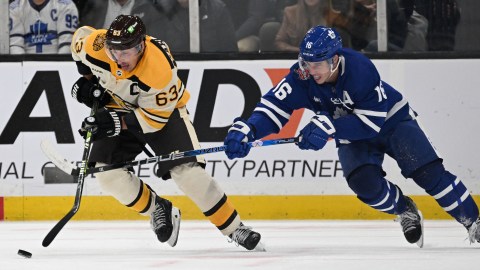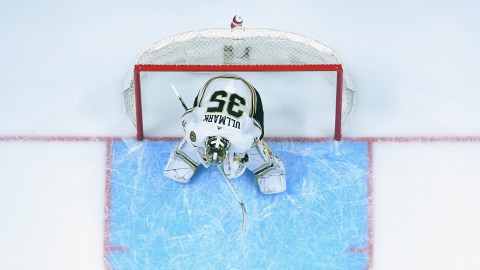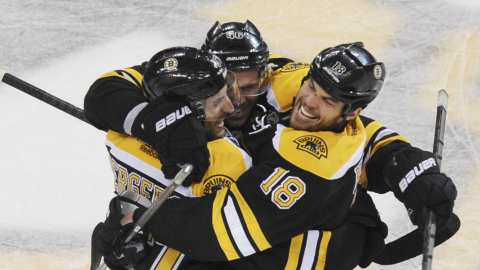Editor's note: This story was originally written in April of 2009, shortly after Bruins forward Milan Lucic had been suspended one game for what was deemed a blow to the head of Maxim Lapierre in the first round of the playoffs. Wednesday's ruling that Matt Cooke won't be suspended for his head shot on Marc Savard can be included as the latest chapter to this story.
The blue lights exploded like fireworks in my rearview mirror, so I
slowed down, pulled over, turned on the dome light and got my license
and registration out of the glove compartment.
I was driving home to northern Connecticut after the Bruins’ charter
had landed. It was December of 2005. The night was clear, cold, and
dry, about 2:30 in the morning. There was no one on the road, save for
that car about a quarter-mile back that turned out to be a
Massachusetts State Police trooper.
I was heading westbound on the Mass Pike. You know that exit to
I-84? Two lanes, downhill, a big left turn at the bottom of the grade,
through the underpass to the toll plaza? I didn’t exactly back off the
accelerator as I took it down the ramp. On went the blues.
After the requisite ID check and a brief chat with me (perhaps to
assess my sobriety), the trooper went back to his cruiser for about
five or six minutes.
He came back and said: “Look. I had you doing 60 down that ramp.
Now, I know that there’s nobody out here and you thought you were in
control of the vehicle. But I’ve seen stuff you never ought to see at
crashes where I’m sure the drivers thought they were in control. This
is my district [I can’t remember if that’s the word he used, but it was
a “turf” statement]. I don’t ever want to see you hit this — or any —
ramp doing more than 40, period. Got it?”
“Yes, sir,” I replied.
“Now, have a good night,” he responded. “Drive safely. And happy holidays.”
I have driven that route well over 100 times since then, and I never
have hit the ramp doing more than 40. That state trooper drew a very
clear line. He left no doubt in my mind. He made his case quickly,
concisely, and decisively. And — most important — he was brilliantly
effective.
Mr. Trooper, have I got a job for you.
The NHL’s grand pooh-bah of punishment is league vice president Colin Campbell. Here is some of what Campbell has seen and done in the last week:
Case No. 1
Daniel Carcillo, the Philadelphia agitator, goes out
to take a faceoff with less than 10 seconds to go in what is going to
be a 4-1, series-opening loss in Pittsburgh. As the puck drops,
Carcillo pops Max Talbot in the head with his top hand, a gloved butt end right on the noggin. The on-ice officials do not call a penalty on the play.
Case No. 2
One night after the widely publicized Carcillo event, Mike Cammalleri, the Calgary wing who tied for second in the NHL with 19 power-play goals, is lined up against Chicago wing Martin Havlat.
The score is 1-1 in the first minute of the third period. (You’ve got
to say this about the information age: Instructional video can be
distributed anywhere virtually instantly, and it works! It looks like a
replay!) As the puck drops, Cammalleri takes his top hand, still on the
stick, and clobbers Havlat. Cammalleri receives a two-minute minor
penalty.
Case No. 3
Two nights after Cammalleri’s punch, Bruins engine Milan Lucic high-sticks Maxim Lapierre
with about five minutes to go in a 5-1 Bruins rout. This time, the
confrontation isn’t on a faceoff. It’s after a goalmouth scrum with
Montreal defenseman Mathieu Schneider. Lucic, after
disengaging from Schneider, turns and sees Lapierre approaching. While
holding his stick, Lucic raises his hands and bonks Lapierre hard
enough with his right glove to knock off Lapierre’s helmet.
Self-defense? Well, it looks more like a pre-emptive attack than
self-defense. Lucic receives a two-minute minor for cross-checking Schneider, a five-minute major for high-sticking Lapierre, and a game
misconduct (which, after the game, was changed to a match penalty — the
important difference being that a match penalty requires review by the
league).
All three cases go to Campbell’s court. Carcillo gets a one-game
suspension, and Philadelphia coach John Stevens gets a $10,000
fine. Cammalleri gets nothing. Lucic gets a one-game suspension.
Here is Campbell’s statement on the official NHL news release: “While it is unclear whether Lucic’s glove or stick makes contact with
Lapierre, what is clear is that he delivered a reckless and forceful
blow to the head of his opponent.”
CBC’s best-in-the-business anchor/host/hockey journalist Ron MacLean
interviewed Campbell at length and got this response regarding the
Lucic suspension: “We felt it was a reckless and careless use of the
stick. Milan is a first-time offender. It was difficult. It was a
playoff game. The player came to Milan in the situation, so there are
always issues. We felt the glove made first contact, but the stick was
there as well, and we felt it was an unnecessary action with the stick
toward the head.”
So why didn’t Campbell say that Lucic was suspended for an
unnecessary action with the stick toward the head? His official
statement, which I am assuming was not an off-the-top-of-the-head
dictation, is deliberately vague. And therein lies the problem.
In the aftermath of the Carcillo and Cammalleri incidents, Campbell
has indicated that many other factors have come into play in his
judgments: the score of the game, the time left on the clock,
Campbell’s assumptions about the coach’s motivation to select certain
players to be on the ice at certain times, whether he has punished
those players previously, whether he considers players involved in
incidents to be bullies, whether the victims of the aggressions
sustained injuries, and other bits and pieces of his personal hockey
experience.
Campbell, in the past, has rolled his eyes and made condescending
statements toward reporters who refer to legal parallels of setting and
following precedent, consistency of sentencing, and clear explanation
of punishments and levels thereof. That kind of fact-based argument
appears to bother him.
Campbell’s record of judgment and punishment gravitates to this:
Rather than reaching a conclusion based on the best logical
presentation of undeniable evidence (no matter how compelling), it is
Campbell’s own personal “feel” about an individual situation that
matters most.
I’ll be darned if anyone can find a pattern. The result of
Campbell’s stewardship is that there are no clear standards for what
“crosses the line” in a violent, emotional, high-stakes team sport
played by some extremely strong and occasionally ill-tempered men. As a
hockey Hall of Famer told me Monday night at Game 3 of the
Bruins-Canadiens series, “The line is so blurry, there isn’t much of a
line.”
Here are the facts on the three incidents Campbell reviewed:
| Action | Carcillo | Cammalleri | Lucic |
| Blow to the head | Yes | Yes | Yes |
| While holding stick | Yes | Yes | Yes |
| Penalized in game | No | Yes | Yes |
| Prior Suspensions | Yes | No | No |
| Suspended | Yes | No | Yes |
So what did you say about how fast I could drive on that exit ramp?
The NHL has gone to great lengths to establish standards on the ice.
Consider how many infuriating ticky-tack “hooking” penalties we have
seen called in the last two seasons: Virtually any contact using a
stick parallel to the ice elicits a hooking call.
Holding? If a player takes one hand off the stick and gets an open
palm on any body part other than the middle of his opponent’s chest or
back, he’s probably going to spend the next two minutes in the box.
There are still some ref-to-ref variables, and a lot of fans (and
players) aren’t happy about the new standards (see Mike Milbury re:
“pansification”), but it’s pretty clear what the parameters are.
Contrast that relative consistency with what comes out of Campbell’s hearings.
Now, spin it back to the “pajamas” game on Feb. 1. Five seconds
left, Bruins winning 3-1. Montreal defenseman Ryan O’Byrne loads up and
cracks Chuck Kobasew in the back of the head, straight into the glass
next to the Montreal bench.
Message sending? You bet.
Penalized? Yup, two minutes for elbowing.
Result of the game in doubt? Nope.
Blow to the head? Obviously.
Attempt to injure? Sure looked like it.
Resulted in injury? No, only because Kobasew wears a visor — otherwise he would have had his nose broken, at least.
Video sent to the league office? Yes.
Suspension? No.
It is to laugh.
The only person who seems to understand Colin Campbell’s pattern of
punishment is Campbell himself. The suspensions he hands down are
arbitrary and erratic — swayed by non-evidence, hunch, gut feelings,
anecdotes and back-channel influence peddlers — and they are almost
never clearly explained. He establishes precedent and contradicts it.
He makes exceptions based on flawed premises and then concludes his
arguments illogically and capriciously. No one, no one, knows what is allowed and what is not allowed. It is Dartboard Justice.
Perhaps there is someone patrolling the highways and byways of
hockey that has the ability to establish standards of punishment; to
draw a clear line that everyone understands; to communicate effectively
with players, coaches, managers and fans; and to make the NHL a fair
and safe place for the world’s most exciting athletes.
But Colin Campbell is not that someone.



